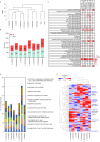Comparative and pharmacological investigation of bEVs from eight Lactobacillales strains
- PMID: 40715596
- PMCID: PMC12297607
- DOI: 10.1038/s41598-025-12873-z
Comparative and pharmacological investigation of bEVs from eight Lactobacillales strains
Abstract
Bacterial extracellular vesicles (bEVs) have therapeutic potential by mimicking the effects of the microbiome. Here, we characterized bEVs from eight gram-positive Lactobacillales strains, evaluating their therapeutic potential. In primary characterization, Lactobacillus paracasei produced the largest bEVs (82.5 nm), while Lactococcus lactis yielded the highest number (3.2 × 10⁹ particles/mL). Lactobacillus plantarum had the highest protein content (0.124 pg/particle), while Lactobacillus salivarius had the greatest lipid content (16.3 µg/particle). Lipid content significantly influenced cytotoxicity in HEK293T cells (r² = 0.366, p = 0.037). Connectivity Map (CMap) analysis revealed correlations between bEVs from Lactobacillus rhamnosus, Lactobacillus fermentum, Lactobacillus acidophilus, and Streptococcus thermophilus and approved drugs for skin health. Experimentally, these bEVs enhanced collagen synthesis in fibroblasts by up to 1.25-fold (p < 0.001). Proteomic analysis identified distinct protein sets for each bEV. Further analysis demonstrated interaction networks between bEV proteins and human proteins that promote collagen production through the JAK-STAT, PI3K-AKT, and focal adhesion pathways. In conclusion, this study highlights the strain-specific characteristics and therapeutic potential of bEVs in promoting collagen production, presenting a novel approach to discovering new indications for bEVs in potential skin care applications.
Keywords: Collagen; Skin health; Therapeutic indications; bEV; bEV-host interaction.
© 2025. The Author(s).
Conflict of interest statement
Declarations. Competing interests: H.-M.Y., H.-J.A., G.-H.C., Y.-S.L., K.-J.K., S.-J.C., and S.-J.K. are employees of HK inno.N. The remaining authors state that they have no conflicts of interest.
Figures




References
-
- Joseph, A. et al. Mesenchymal stem cell-conditioned media: A novel alternative of stem cell therapy for quality wound healing. J. Cell. Physiol.235, 5555–5569. 10.1002/jcp.29486 (2020). - PubMed
Publication types
MeSH terms
Substances
Grants and funding
LinkOut - more resources
Full Text Sources

